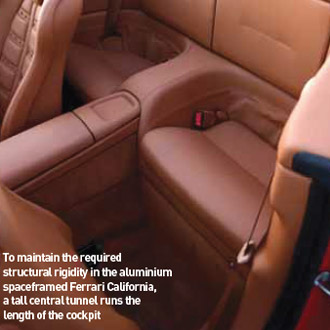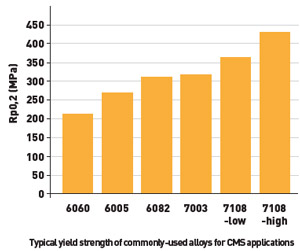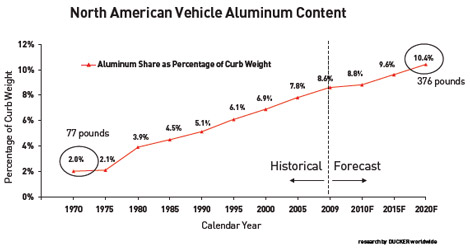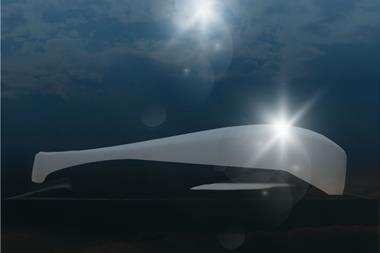In the past, aluminium chassis and bodyframing has tended to be the preserve of supercars and advanced prototypes. Increasingly, with the pressure of high fuel prices and demands for cleaner-running vehicles, OEMs are looking to the light alloy to ‘green’ their next generation of lower and mid-segment cars.
As an example, Alcoa Wheel and Transportation Products recently announced that it has been selected by Ferrari to supply the all-aluminium spaceframe for the Ferrari California (production of which is covered on page 20 in this issue).
Kevin B. Kramer, President, Alcoa Wheel and Transportation Products: “The strength and lightweight advantages of Alcoa’s aluminium technologies allow Ferrari to maximise performance, strength and structural rigidity of the California to meet customer expectations and most importantly, help increase performance while lowering vehicle weight to deliver increased fuel economy and lower CO2 emissions. Particular attention was paid to fuel consumption levels, which in the case of the Economic Commission for Europe (ECE) combined cycle is 13.2 litres per 100 kilometres, with CO2 emission levels of around 310 grams per kilometre.
“Working closely with Ferrari from the start of the project allowed Alcoa to maximise strength for the open-top, twoseat sports car, while reducing mass and weight to increase performance,” says Kramer.
Alcoa’s spaceframe manufacturing facility is located in Modena, Italy, close to the Ferrari plant and as such was able to respond rapidly to changes in specification during the development phases of what is an entirely new type of frame for the carmaker.
 Mercedes-Benz and AMG introduced the new SLS AMG in September 2009 at the IAA Frankfurt Motor Show in Germany. The 6.3-litre V8 front-mid engine sports car features an aluminium spaceframe body, as well as a dry sump lubrication, a seven-speed dual-clutch transmission in a transaxle configuration, and a sports suspension with aluminium double wishbones. Weighing in at 1,620kg, the reinterpretation of the legendary ‘gullwing’ is scheduled for launch in Spring 2010.
Mercedes-Benz and AMG introduced the new SLS AMG in September 2009 at the IAA Frankfurt Motor Show in Germany. The 6.3-litre V8 front-mid engine sports car features an aluminium spaceframe body, as well as a dry sump lubrication, a seven-speed dual-clutch transmission in a transaxle configuration, and a sports suspension with aluminium double wishbones. Weighing in at 1,620kg, the reinterpretation of the legendary ‘gullwing’ is scheduled for launch in Spring 2010.
Lightweight aluminium sections in the space frame connect the force nodes to a sturdy base structure. The large, low-set cross sections of these aluminium parts are intended to ensure high-resistance torque, thus providing the required direct transfer of drive, braking and suspension forces. According to Mercedes-Benz, the structure prevents unwanted flexibility. Forty-five per cent of the spaceframe is made out of aluminium sections, 31% of aluminium sheet, 20% out of aluminium cast and 4% out of steel - the whole bodyshell weighs 241kg. The front/rear weight distribution of 47 to 53%, combined with the vehicle’s low centre of gravity, are in tune with its super sports car aspirations. With a double-wishbone axle, the wheel location and suspension function remain separate, the spring/damper struts supported on the lower wishbone. The double-wishbone concept, with its high camber and track rigidity, positively locates the wheel with minimal flex. Wishbones, steering knuckles and hub carriers at the front and rear are made entirely from forged aluminium, substantially reducing unsprung masses and improving suspension response.
 A lightweight Audi A5 Coupe prototype has slimmed down by over 100kg by swapping steel for advanced aluminium and carbon fibre construction. The A5 project is the latest example of the pioneering work undertaken by the German carmaker to extend efficiency optimisation measures beyond the engine bay.
A lightweight Audi A5 Coupe prototype has slimmed down by over 100kg by swapping steel for advanced aluminium and carbon fibre construction. The A5 project is the latest example of the pioneering work undertaken by the German carmaker to extend efficiency optimisation measures beyond the engine bay.
Taking an existing steel-bodied production car as its basis, the A5 project clearly demonstrates the benefits of the aluminium Audi Space Frame (ASF), initiated by Audi 15 years ago and which still serves to evolve and improve material usage. Use of ASF principles reduce the weight of the car body by at least 40% when compared with conventional steel construction, demonstrated in a kerb weight of 1,310kg for the aluminium A5 prototype, versus 1,420kg for the equivalent steel production model.
Thanks to the significant weight loss, achieved by mounting aluminium and carbon fibre-reinforced plastics onto the aluminium ASF, the A5 prototype is able to use a four-cylinder engine - with its attendant economy and emissions advantages - to deliver performance figures similar to that of a higher-output V6.
The lightweight design of the test car not only enables a smaller engine to supplant a larger one with no impact on performance (and gains in economy and emissions), it also has a knockon effect on ancillaries such as the brakes and transmission, which can also be reduced in size and weight.
Lightweight construction experience
Over the past 15 years, Audi has employed ASF principles over two generations of the A8 luxury saloon, in the hyper-efficient, ahead-of-its-time A2 compact hatchback and in the celebrated R8 supercar. ASF has also been re-interpreted in the creation of the latest TT Coupe and Roadster, which feature advanced steel and aluminium ‘hybrid’ construction that allows for outstanding weight distribution.
“One of our most enduring aims for the future is to reverse the weight spiral,” says Michael Dick, member of the Board of Management of AUDI AG responsible for technical development. “Lightweight design is the foundation of our entire approach to improving efficiency.”
Lightweight vehicle structures must become a central part of every car company’s range as electric and hybrid/ alternative fuel vehicles come on stream. The electric drives of the future will add additional weight to the car and will initially only offer a limited range, making systematic lightweight design all the more important.
 Audi first reversed the weight spiral with its A8 model of 1993. Such weight savings has significant advantages; every 100kg saved reduces fuel consumption by 0.3 to 0.5 litres per 100 kilometres, corresponding to a reduction of between 8 and 11 grams of CO2 per kilometre. A lighter body is also the starting point for weight reductions on other parts of the car, such as the chassis or the fuel tank.
Audi first reversed the weight spiral with its A8 model of 1993. Such weight savings has significant advantages; every 100kg saved reduces fuel consumption by 0.3 to 0.5 litres per 100 kilometres, corresponding to a reduction of between 8 and 11 grams of CO2 per kilometre. A lighter body is also the starting point for weight reductions on other parts of the car, such as the chassis or the fuel tank.
Compared to steel, an ASF body is at least 40% lighter.
The body of the first A8 weighed only 249kg; the body of the A2 compact (from 1999) weighed only 156kg. The superstructure of the A2 1.2 TDI weighed in at only 135kg, a decisive factor in the A2’s average fuel consumption of 2.99 litres of fuel per 100km – the world’s first so-called ‘threelitre’ car.
Audi does not always get the weight/cost equation right.
While a technical success, the A2 proved a loss leader. The car was expensive for the customer – more so than the larger Renault Mégane Scenic – and with its premium-class car finish and high specification, could not make a profit. The company’s new A1 will be steel, still probably quite light and crashworthy, but offered at a competitive price. There’s still some way to go before aluminium can be considered a material for the everyman.
The SuperLIGHT-CAR project – lighter and leaner
SuperLIGHT-CAR is a collaborative R&D project co-funded by the European Commission under the 6th Framework Programme. In SuperLIGHT-CAR, 38 leading organizations from nine European countries work together to bring lightweight automotive technologies closer to high-volume car production.
 SuperLIGHT-CAR has a multi-material philosophy, striving to use the best material and manufacturing process for each part in terms of weight and cost minimization, while fulfilling a wide range of automotive requirements in areas such as stiffness, crash performance, fatigue and corrosion resistance.
SuperLIGHT-CAR has a multi-material philosophy, striving to use the best material and manufacturing process for each part in terms of weight and cost minimization, while fulfilling a wide range of automotive requirements in areas such as stiffness, crash performance, fatigue and corrosion resistance.
The driving force behind SuperLIGHT-CAR has been a group of seven European carmakers: Volkswagen (as co-ordinator), Fiat Research Centre, Opel, Renault, Volvo Technology Centre, Porsche and Daimler. Together with scientific organizations such as the Fraunhofer Institutes, Deutsches Zentrum für Luft- und Raumfahrt and Commisariat à l´Énergie Atomique, as well as the industry suppliers Arcelor, Hydro, Corus and Comau, these companies have defined the SuperLIGHT-CAR approach.
The project has an ambitious objective; it aims to deliver the technologies and design concepts that will allow up to a 30% weight reduction in future generations of C-class models, while respecting the very demanding cost restrictions of these popular vehicles.
SuperLIGHT-CAR coordinates with other major RTD projects co-funded under the 6th Framework Programme through the EUCAR umbrella (EUCAR: European Council for Automotive Research). The precompetitive achievements of SuperLIGHT-CAR applied in series production beyond 2010 will serve to save millions of tons of fuel and carbon dioxide emissions due to significantly reduced vehicle weight.
After more than four years of intensive co-operation, the 38 partners in the ‘SLC’ project on ‘Sustainable Production Technologies of Emission Reduced Light-weight Car concepts’ recently presented their results at a final conference in Wolfsburg, Germany. The involvement of the aluminium industry was based on the Lightweight Aluminium-intensive Automotive Solutions (LAAS) EU project application initiated by the European Aluminium Association, which was later invited to join other EU project applications relative to automotive materials, resulting in the Multimaterial SLC project.

High-strength aluminium alloys (HSAlu), with a yield strength from 300 MPa, and ultra high-strength aluminium alloys (UHSAlu), with a yield strength of 400 MPa and above, are well known from the aerospace sector. Today, HSAlu and UHSAlu alloys suitable for extrusion are making inroads into the automotive sector. Due to their excellent strength-to-weight ratio and crash performance, these aluminium alloys were used in about nine million crash management systems produced in Europe in 2008. So why use HSAlu & UHSAlu in crash management systems when ultra high-strength steels (UHSS) can provide yield strengths three times (or more) greater than those of HSAlu and UHSAlu alloys?
At first glance, considering the material densities of steel and aluminium, the aluminium solution would seem, at best, to have the same weight as the steel one.
Thin sections are, however, susceptible to premature ‘compression buckling’ collapse, preventing UHSS from reducing thickness down to one third that of aluminium. Taking this fact into consideration, and also fully exploiting the design flexibility of an extruded profile, HSAlu and UHSAlu typically allow for a 30% weight saving in bumper beams in comparison with a UHSS solution, and a weight saving of between 40 and 60% in crash boxes in comparison with high-strength steels.
Volkswagen was in the driver’s seat of the SLC project. Its partners were other European car manufacturers such as FIAT, Daimler, Porsche, Renault, Volvo and Opel. In addition, there were 10 R&D companies, 10 automotive suppliers, seven universities and three SMEs. As a basis, they took a Golf V BIW and sought the best way to redesign it.
Even though they did not end up with an all-aluminium car, the agreed approach was a new multi-material (MM) light-weight design, with aluminium emerging as a clear winner against competing materials, including new steel alloys, polymers/plastic composites and magnesium. The project achieved weight savings of approximately 35%, or about 100kg.
Hydro covered all the major issues of aluminium application and R&D, while Aleris, represented by Corus R&D, brought in its competence and activities involving aluminium sheet. During the entire project, Jürgen Hirsch, senior scientist at Hydro’s R&D centre in Bonn, and Chris Lahaye, group leader of aluminium metallurgy at Corus RD&T for Aleris, worked on the SuperLIGHT-CAR.
Conditions that needed to be met included:
- Same or improved structural and safety performance
- Limited cost (about €7 per kilogram of weight saved)
- Mass production capability (more than 1,000 cars per day)
- Environmentally-friendly, recyclability and life-cycle analysis (LCA)
The aluminium experts had a great deal more to accomplish than merely shedding kilograms, yet by combining solutions and R&D results, they arrived at a super result: the OEM partners chose aluminium for the final SLC concept as the ideal light-weighting material in most BIW parts, accounting for more than half of the total weight.
The development and evaluation process was based on intensive simulation, including structural and crash performance, material and fabrication costs, and LCA issues.
What makes the results of this project truly spectacular is the fact that aluminium obviously played a leading role in the innovation benchmark of the SLC project, setting the highest standards as the new reference for any light-weight car design.
In other words, we can expect a lot more business for aluminium, in a future geared towards lighter cars.


































